Since it was founded in 1890, Illinois Institute of Technology has embraced a progressive view of diversity, welcoming students and faculty of all races and ethnicities, even during years of segregation. Increasing diversity is a priority of the university today, and IIT’s African-American alumni, students, and faculty are proving that success is colorblind.

A Rich History
As an engineering student at IIT, Frank Crossley could appreciate the value of an experiment. When he joined a United States Navy V-12 Program in 1944 that paid for his tuition and led to a commission as an officer, he became part of the experiment the Navy had no black officers at the time, and the commanding officer of the IIT unit told him the government was interested in testing whether white military personnel would take orders from black officers.
It worked. Crossley was assigned to the U.S.S. Storm King at the tail end of World War II, and soon had 36 men reporting to him, including one officer. For two days he felt like a curiosity to his fellow crew members, but soon, he remembers, the enlisted men regarded him like any other officer. A fellow officer even overheard a sailor telling a friend that, “All the officers on this ship are S.O.B.s except Mr. Crossley.” Crossley’s success, along with that of the other African Americans in the program, influenced President Harry S. Truman to outlaw discrimination in the military in 1948.
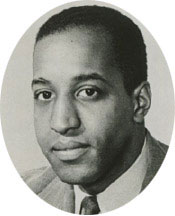
Crossley’s impact didn’t stop with the Navy. As a renowned metallurgist at aerospace firm Lockheed Martin in the 1970s, he received a patent for inventing a new class of titanium alloys.
Crossley is one of many African-American graduates of IIT who have made landmark contributions in professions ranging from engineering and architecture to law and journalism. Along the way, IIT’s African-American alumni have also been at the forefront of the struggle for civil rights in America.
First, there are the pioneers. Ida Platt, who earned her law degree from Chicago College of Law in 1894, is believed to be the first African American woman to pass the bar in Illinois. (Chicago College of Law and Kent College of Law merged in 1900, and became IIT Chicago-Kent College of Law in 1969).
Charles Pierce, a 1901 graduate of Armour Institute of Technology, was the nation’s first African-American graduate in chemical engineering. Pierce later taught at DuSable High School in Chicago while Crossley was a student there. (Armour merged with Lewis Institute in 1940 to create IIT.)
Then there’s Gloria Ray Karlmark, who had already done her pioneering when she arrived on campus. The 1965 graduate came to IIT from Little Rock, Ark., where she was one of the famed “Little Rock Nine”, the nine students who attended previously segregated Little Rock Central High School under the U.S. Army’s protection in 1957.

The university’s highest-profile African-American alumnus may be Robert Abbott (LAW 1900), who founded the newspaper The Chicago Defender. Through the Defender, Abbott campaigned against racial injustice; his suggestion that southern blacks move north to escape discrimination helped draw more than 50,000 southern African Americans to Chicago between 1915 and 1920.
IIT has consistently graduated African Americans who are leaders in their fields. Other notable alumni include Henry McGee (PA ’49), who became Chicago’s first black postmaster in 1966; Stephen Burks (ID ’92), who the New York Times Style Magazine hailed in 2005 as “the first African American to make an impression on the rarefied world of international industrial design”; Perri Irmer (ARCH ’81), who runs U.S. Cellular Field as chief executive officer of the Illinois Sports Facilities Authority; and Dorothy Brown (LAW ’96), current clerk of the Circuit Court of Cook County, who became the first African American to hold that position when she was elected in 2000.
In the 1940s and 50s, there were fewer black students, but those who attended say the culture at IIT was supportive because they and their work were regarded on par with fellow students, regardless of race.
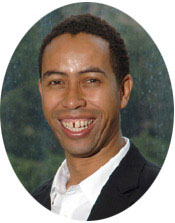
“I don’t know how long I was around IIT until anyone in the administration knew I was black,” says David Sharpe (ARCH ’60, M.S. ’62), who came to IIT as a student in 1956 to study under Ludwig Mies van der Rohe and joined IIT’s architecture faculty full-time in 1982 after a 20-year career at Chicago architecture firm Skidmore, Owings, and Merrill (SOM). While at SOM Sharpe also taught part-time at IIT. “[Race] just wasn’t something that was important to Mies, so it didn’t come up,” he says.
Over time, the university attracted more black students, who supported and challenged one another.
“We had a drive to succeed that came from an understanding that our success or failure would impact the perception of the African-American students who would follow us,” says Jeff Carroll (ME ’94), who works in business development at Siemens Business Technologies in Chicago. “If a classmate was feeling like they couldn’t cut it, we would reach out to them, encourage them, help them with their understanding of the curriculum—whatever it took for all of us to graduate.”
Two important programs that drew minority students to IIT and into the engineering and science professions were initiated in the 1970s and 1980s. IIT’s Early Identification Program, headed by Nathaniel Thomas, worked to increase the number of African-American students at IIT to nearly 12 percent of the undergraduate student population and Hispanic students to nearly 10 percent. The Early ID program lost federal funding in the late 80s.
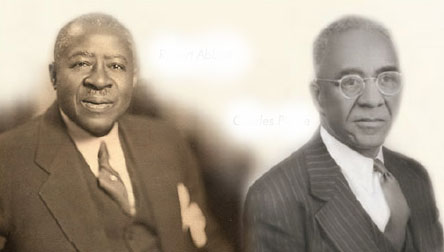
The Chicago Area Health and Medical Careers Program (CAHMCP, pronounced “Champs”), a State of Illinois-sponsored consortium of Chicago-area medical and dental schools, IIT, and several health-focused community groups, was started in 1979. The program works as a pipeline to identify and recruit underrepresented minorities’ as early as in the seventh grade into medical professions. Led by Reggie Jones and John Bradley, CAHMCP is housed on IIT Main Campus and continues to serve as a novel approach to minority recruitment.
“Both the Early Identification program and CAHMCP have single-handedly been responsible for IIT’s efforts to help create trailblazers in the underrepresented minority population,” says Kevin Smith (CS ’89), executive director of the Office of Multicultural Student Services (OMSS).
Some of IIT’s African-American alumni, like Crossley, see themselves as barrier breakers and standard bearers for fellow African Americans. Others have viewed race as playing a less predominant part, as Sharpe notes, “I’ve never had a desire to be anybody’s role model. I’m just interested in doing good work.” In all cases, they’re part of a legacy of success at a university that has long sought to foster limitless discovery and achievement in all of its students.
Diversity on Campus Today
The community of African-American students at IIT is small but close-knit. The university wants to increase its numbers and is looking to do so by both recruiting more minority students and retaining those already studying here through programs that allow them to acclimate and succeed.
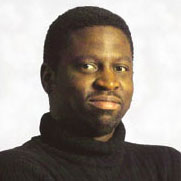
Local recruitment efforts include partnerships with Chicago Public Schools (CPS), where 52 percent of students are African American. Each semester IIT partners with 8-12 CPS high schools to provide students campus tours that showcase the unique IIT educational experience through lectures and Interprofessional Projects demonstrations. The university also co-hosts college fairs that introduce CPS students and their families to the college admission process. Through the Advanced Mathematics Program, IIT offers Jones College Prep students advanced calculus courses at the university, providing tuition waivers and covering the cost of books. And launched in academic year 2007-08, the Collens Scholarship Program awards full-tuition scholarships to talented CPS graduates whose annual family income is less than $40,000.
The Department of Mathematics and Science Education (MSED) continues its collaboration with CPS through programs that foster engagement in math and science at the middle school and high school level. The Way2Go summer program introduces science concepts to students entering the eighth grade. In its second year, the CPS High School Transformation project, funded by the Bill and Melinda Gates Foundation, pairs MSED with The Field Museum and Glencoe Publishing to provide teachers professional development in science. Through their teachers’ enhanced science knowledge and teaching ability, students obtain an improved understanding and achievement in the subject, and increased awareness of science as a career.
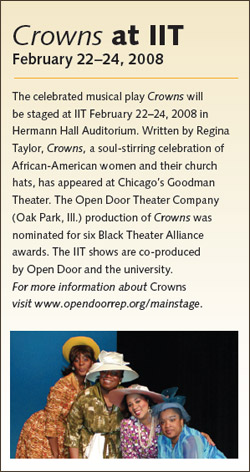
For students outside Chicago, IIT’s Office of Undergraduate Admission has piloted and plans to expand a Fly-In Program that underwrites the cost of travel, enabling newly admitted students with financial need to visit campus before the beginning of their freshman year. This and other minority recruitment initiatives are being studied and developed by the offices of undergraduate admission and financial aid, and also by a designated subcommittee of the Retention and Student Life Task Force. IIT has also created a new Committee on Diversity, which will take a lead role in improving diversity university-wide.
Retention is as important as recruitment, and the Office of Undergraduate Admission in conjunction with the Office of Undergraduate Academic Affairs is launching a new campaign to help retain minority students. Through a rigorous advising platform, students’ academic success and career goals will be monitored, with additional counseling, mentorship, and support services offered for students needing them. On-campus living is also important to these retention efforts, according to Herek Clack, a member of IIT’s minority student retention committee and an African-American member of the engineering faculty.
“Our African-American students now are more flexible and better able to maneuver in an environment where there are few students of color than those of my generation. They’re reporting that even where they may be the only black student in class, they’re reaching out and forming friendships, forming study groups,” says Clack. “If you live on campus, you’re far more likely to form those social bonds and join those groups.”

Student organizations such as the Black Student Union and IIT’s National Society of Black Engineers chapter plan social and professional events, and their leaders agree that it is important to build the number of black students who live on campus. Christian Hubbard, a senior architecture major and president of the BSU, says his organization struggles to draw commuter students at its evening events and acknowledges that living on campus helps him feel more connected to IIT.
“I’ve spent so much time in S. R. Crown Hall—once I put in four all-nighters in a row—and people there with me, the better students in class, have become my friends,” says Hubbard. “I see what they’re making and hear what they’re reading, and that helps make me better.”
Adjusting to college life can be challenging, though, for black students. In addition to the usual adjustments associated with starting college, there can be a significant culture shock.
“Black new students come in with a slight disadvantage because there are not many groups of people on campus they can quickly and easily relate with. They meet faculty and students who are very different from where they came from,” says Ikechi Emelogu, a senior electrical engineering major and president of IIT’s NSBE chapter.
Groups like the NSBE and BSU help build that community, in conjunction with the Office of Multicultural Student Services (OMSS), which also provides academic support and other resources. This includes the new High Performance Institute (HiPI), designed to connect underrepresented minorities with academic and co-curricular programs such as academic assistance, cultural enrichment, and social engagements.
“Black students have needs that are different than those of other students—for instance, commuters or students in fraternities. We can’t make the mistake of generalizing and not addressing their needs,” says Kevin Smith. “As we look at how we recruit black students, we need to make sure we have the resources in place to support them.”
The Mirror Shatters
By the time Armour Institute of Technology and Lewis Institute merged in 1940 to create Illinois Institute of Technology, the surrounding Bronzeville neighborhood, once booming in the 1920s following the Great Migration, had fallen hard. Many of its once opulent buildings were in disrepair, victims of the Great Depression. During this time, IIT participated with the City of Chicago in an urban renewal effort that required the razing of many of Bronzeville’s legendary structures where Main Campus now sits. Later in the 1950s and ’60s, the Chicago Housing Authority built public housing projects like Stateway Gardens and the Robert Taylor Homes at the edge of campus.
While the relationship between university administrators and community leaders soured in the mid-1900s, taking on an adversarial tone that persisted for decades, IIT officials later changed their approach. In 1989, the university hired a neighborhood advocate, Leroy Kennedy, to direct the university’s community relations efforts. Following the recommendations of the National Commission for IIT, created in 1992, the university decided to work with neighborhood leaders to improve the area and to reinvest in Bronzeville.
“IIT has grown even though the neighborhood has experienced mounting problems,” says Kennedy, IIT’s vice president of community affairs and outreach. “We have an obligation to help come up with some of the solutions.”
Community leaders say they can feel the difference that’s occurred because of the university’s new commitment.
“The university has begun to look at the neighborhood as an asset, as something of value, and the students now see the place where they live as a destination—something that adds value to their experience,” says Leonard McGee, president of the Gap Community Organization, a neighborhood within Bronzeville. McGee cites the new IIT Collens Scholarship Program as a sign of commitment to the neighborhood, as well as a technology-training program for area teachers. “The university and the community have a symbiotic relationship—arm in arm, we can achieve a level of success that’s beyond our reach separately.”
“The university has stepped up as a partner,” says Harold Lucas, president of the Black Metropolis Convention and Tourism Council. In March 2007, IIT provided financial support toward a bid to designate parts of Bronzeville as a National Heritage Area, the latest in a series of university-supported projects to benefit the neighborhood. Other initiatives range from providing Web hosting for local community groups to supporting the restoration of some of the remaining historic buildings from Bronzeville’s golden age. The housing projects south of Main Campus are gone, replaced by mixed-income housing and retail businesses such as Starbucks that both employ and cater to neighborhood residents.
Third Ward Alderman Pat Dowell, whose territory includes Bronzeville, says IIT has fueled the neighborhood’s rebirth. She points not only to the university’s more visible contributions, like the financial support for the heritage district, but also to the way that university staff have become active in neighborhood groups; IIT students and faculty serve as tutors for area schoolchildren. Says Dowell: “IIT recognizes its role in the community and reaches beyond its walls to serve.”
Alumnus James Peters
A Charge for Integration
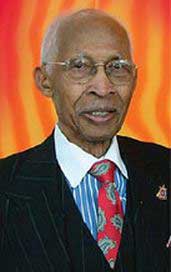
It’s been more than a half-century since James S. Peters II (M.S. PSYC ’52) earned a master’s degree from IIT. The 90 year old sometimes needs a wheelchair to get around, but the energy and ideals that propelled him into a successful career as both a clinical/counseling psychologist and professor, as well as toward a lifetime of social justice advocacy, remain undimmed.
Peters came to IIT after serving as a specialist teacher psychologist for three years in the United States Navy at the U.S. Naval Training Center in Great Lakes, Ill., in a segregated camp for “negroes.” However, in part due to his research on the relationship between black and white sailors, the Navy desegregated its ranks in 1945, three years before President Harry S. Truman ordered the other branches of the military to do so.
“My research showed that African-American sailors, if given the opportunity, could do the same things that white sailors did,” he says.
Peters’ passion for civil rights began during his youth. “We always felt that some day we would have equal citizenship in spite of the Jim Crow laws, segregation, and discrimination,” says Peters, who was born in Arkansas and grew up in Louisiana. “We always worked hard to get an education and do the right thing. We were not taught to hate white people because there were a number of very fine whites who resented the fact that we were segregated as we were.”
His experience at IIT was positive. He did not encounter any racial prejudice at the university and was welcomed on campus from the start. “I was right at home; everyone was so nice to me,” Peter says of his time at IIT. “The community seemed to be glad to have me there, and I won’t forget it.”
Former Department of Psychology Chair P. S. Shurrager and his wife, who was also a professor, were two of those people. So was Professor David Boder, who supervised Peters’ master’s thesis about the psychological and social problems of black and white veterans.
After graduating from IIT in 1952, Peters spent about a decade with the Veterans Administration in the beginning of a distinguished career as a clinical/counseling psychologist. He also continued to work for social justice, eventually meeting and becoming friends with fabled civil rights leaders, including Martin Luther King Jr.
Peters’ attentions have not been limited to the rights of African Americans. Beginning with his time in the military, Peters also has advocated for the rights of people with physical and mental disabilities. He served for 25 years as associate commissioner of the State Department of Education and state director of vocational rehabilitation for the State of Connecticut.
Peters’ related concerns of psychological testing and civil rights are reflected in his writings, which cover a wide range of topics. In October 2007 he sent his 26th book to print. In addition to scholarly titles, including a source book of research by black psychologists and Social Justice for the Disabled, Peters has written three memoirs and two books of poetry.
He and his late wife, Marie, who was associate professor of family studies at the University of Connecticut, have three children and three grandchildren.
Peters has garnered many honors—a particularly noteworthy one came in 2005, when he was named to the Connecticut Veterans Hall of Fame—and he says that the education he received at IIT played a significant role in his accomplishments.
“It enabled me to continue on for my Ph.D. at Purdue University and post-doctorate work at Harvard University School of Medicine, and practice my profession,” Peters says. “Drs. Shurrager and Boder took me in and they encouraged me.”
—Jeff Kelly Lowenstein
Black History Month Events at IIT
The 2008 theme of IIT’s Black History Month events is Our Foundation: Celebrating Founders, Trailblazers, and Today’s Trendsetters.
Kickoff Celebration
Friday, February 1, 2008
12:15 p.m.
Main Campus, MTCC Ballroom
Keynote speaker: Perri L. Irmer (ARCH ’81), chief executive officer of the Illinois Sports Facilities Authority
Special performances by the Northwest Indiana Dance Alliance
Soul food reception and special recognition of black student leaders
Soul Food Friday and Umoja Marketplace
Friday, February 15, 2008
11 a.m.–2 p.m.
Main Campus, MTCC Welcome Center and Ballroom
Special teaser performance of Crowns, a musical play by Regina Taylor
Crowns
Friday, February 22–Sunday, February 24
Main Campus, Hermann Hall Auditorium, 3241 S. Federal Street
Special scholarship performance on Friday, February 22 for the Charles Pierce Scholarship Program and Open Door Repertory Company
Invited Guest Alumni Speakers for Black Student Organizations throughout February 2008
African Student Organization: Justin Akujieze (PHYS Ph.D. ’91) interim dean, School of Graduate and Professional Studies, Chicago State University
Black Student Union: Cheryl Hudson-Jackson (MGT ’83) and Eric Fullilove
(EE ’94)
National Society of Black Engineers: Lerry J. Knox (MET ’95), senior vice president, Loop Capital Markets
For more information, contact Kevin Smith (CS ’89), executive director of the Office of Multicultural Student Services, at omss@iit.edu or 312.567.5250